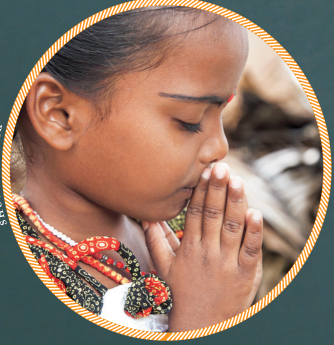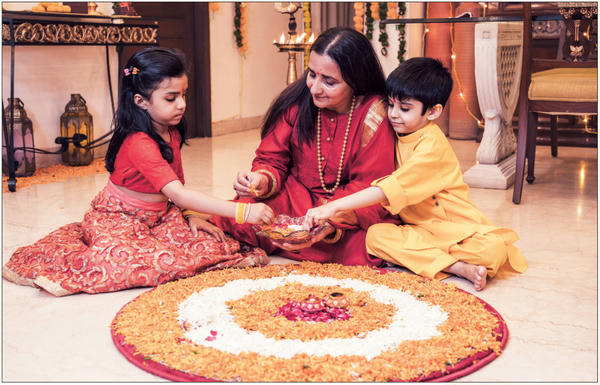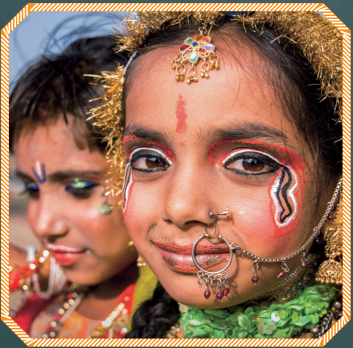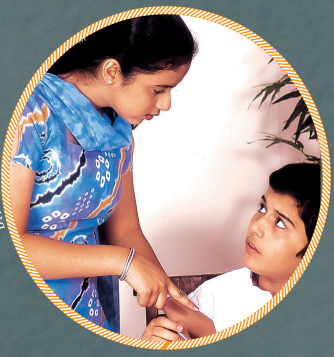PART ONE
TEACH AND PRACTICE HINDUISM IN YOUR HOME
Take responsibility for being the primary teachers of Hinduism to your children
It is wonderful that many temples have in place educational programs for the youth that are both effective and popular. However, it is important for parents to have the attitude that these programs supplement but do not replace the need for them to teach Hinduism to their children in the home. Parents are indeed the first guru. They teach in different ways: by example, explanation, feedback and giving advice and direction. The child’s deepest impressions come from what the parents do and say. If parents follow a systematic approach to teaching children Hinduism during the formative years, Sanatana Dharma will be fully integrated into their minds, assuring that it will be with them for life.
Without your help, there is no guarantee that your children will follow their faith as adults
Look around at the younger generation of Hindus and you will find many who have no interest whatsoever in the Hindu religion. One hundred years ago, before movies, television and computers, in the cities and villages of India and Hindu communities in other countries, the Hindu temple was the most interesting place in town. Besides the pujas and festivals, there were dramas, dances, discourses and musical concerts. The temple was a social and educational center as well. In our modern world we have compelling movies, television and computers, and many Hindu children would much rather spend their free time enjoying these with their friends than being at the temple. Why is this? There are many reasons. Nowadays, families are not so close. And it used to be far easier to get children to come to the temple, since it was the center of village life and there was not much competition for their attention. Times are different. Today’s children often consider the temple boring compared to the all-pervasive and ever more compelling secular forms of entertainment that are available. So, parents are challenged more than ever to answer kids’ puzzling queries—as grandparents did not have to do—by giving sensible, pragmatic explanations of temple worship and Hinduism’s rich array of cultural and mystical practices. Kids today want answers that make sense to them. They are not at all content with “That’s the way we have always done it.” When parents are unable to meet this challenge, Hinduism does not become meaningful and useful to their children. Many youth today do not view the practice of their faith as important to making their life happier and more successful. This is the challenge every Hindu parent faces. But all is not lost. New generations are eager to hear the lofty truths, and those truths can be explained in ways that engage and inspire young seekers, counterbalancing the magnetic influences of the modern world.
Establish a shrine in the home
Hinduism is in no way more dynamically strengthened in the lives of children and the family than by establishing a shrine in the home. The home shrine works best when it is an entire room. That way it can be strictly reserved for worship and meditation, unsullied by worldly talk or other activities. This is the ideal. However, when that is not possible, it should at least be a quiet corner of a room, more than a simple shelf or cabinet.
Naturally, as important as having a shrine is worshiping there daily. In the shrine room offer fruit, flowers or food. Visit your shrine when leaving the home, and upon returning from work or outings. Worship in heartfelt devotion, clearing the inner channels to God and the Gods, so their grace flows toward you and loved ones. Make the shrine a refuge where all family members can find peace and solace, where they can connect with the Gods and offer their praise, prayers and practical needs. Train your children to worship in the shrine before any important event in life, such as a major exam at school, or when faced with a personal challenge or problem. Following this simple, traditional practice in a sacred space within the home will do much to make Hinduism relevant to them on a day-to-day basis.
Worship together in the home shrine each morning
A popular saying in English is “The family that prays together stays together.” In Hinduism, ideally this refers to all members of the family participating in the morning worship in the home shrine before breakfast. The children can be trained to always bring an offering of a flower or at least a leaf. The exact routine followed depends on the family’s religious background and lineage. Typical practices include a simple arati or a longer puja, singing devotional songs, repeating a mantra, reading scripture and then meditating or performing simple sadhanas and yogas. As the children get older, they can take on greater responsibilities during the morning worship. A number of Hindus have told us that what kept them a staunch, practicing Hindu, despite exposure in their youth to other religious traditions at school and elsewhere, was the fact that the entire family practiced Hinduism together in the home.
Worship together as a family at a local temple once a week
Attending a puja at the temple every week allows us to experience the blessings of God and the Gods on a regular basis. This helps keep us pure as well as strong in our religious commitments. The religious vibration of the home shrine is also strengthened by going to the temple regularly. Specifically, some of the spiritual atmosphere of the temple can be brought home with you if you simply light an oil lamp in your shrine room when you return from the temple. This sacred act brings devas who were at the temple right into the home shrine room, where from the inner world they can bless all family members and strengthen the religious force field of the home.
CHARACTER BUILDING, PART ONE
CULTIVATE NINE SPIRITUAL QUALITIES
Parents can consciously and systematically develop key qualities in their children that will help them to be happy, religious and successful when they reach adulthood. A wise mother e-mailed me once saying, “I truly believe we live out part of our karma through our children, and we grow and improve as they do.” Though parents may think they are just helping their children improve, in truth parents cannot separate themselves from their children. The child’s growth and spiritual evolution is the parents’ as well. There are many qualities we want our children to possess. We will explore nine of these to see what children should be taught, or not taught, by parents to develop each quality. The nine qualities are:
 Positive Self-Concept
Positive Self-Concept
 Perceptive Self-Correction
Perceptive Self-Correction
 Powerful Self-Control
Powerful Self-Control
 Profound Self-Confidence
Profound Self-Confidence
 Playful Self-Contentment
Playful Self-Contentment
 Pious Character
Pious Character
 Proficiency in Conflict Resolution
Proficiency in Conflict Resolution
 Parental Closeness
Parental Closeness
 Prejudice-Free Consciousness
Prejudice-Free Consciousness
1. DEVELOP A POSITIVE SELF-CONCEPT
A positive self-concept arises when we think of ourselves as a worthy individual deserving of a wonderful life. How is this accomplished? It is through being generous with your praise and appreciation, making children know they are loved and valued, that who they are makes a difference and life is full of promise. Unfortunately, many children reach adulthood with a negative self-concept, feeling that others are better than they are and life has little to offer. A negative self-concept is developed through verbally running down a child through teasing, joking or insulting remarks. This, of course, needs to be stopped and replaced with encouragement and praise. When it becomes necessary to correct misbehavior, it is wise to distinguish between the person and the behavior. The behavior was foolish, not the person. For example, you can tell your children when they misbehave, “What you did was very foolish, but you are smart, and I’m sure you now know better and won’t do that again.” Parents should also not allow their children to call each other names, such as “fat” or “lame.” Having a positive concept about one’s outer self allows the child to accept the Hindu teaching that one’s inner self is a divine being, a radiant soul. My Gurudeva wrote: “Praise your children. Celebrate their Divinity. Enjoy them and enjoy good times with them.”
PART TWO
TEACH ABOUT THE SOUL AND OUR PURPOSE ON EARTH
Teach that life’s purpose is spiritual advancement
The Hindu view of life is that we are a divine being, a soul, who experiences many lives on Earth, and that the purpose of our being here is spiritual unfoldment. Over a period of many lives we gradually become more spiritual and are thus able to experience divine consciousness more deeply. This eventually leads to a profound experience of God, which brings to a conclusion our pattern of reincarnation on Earth. This achievement is called moksha, liberation. A great lady saint of North India, Anandamayi Ma, stated the goal of God Realization quite beautifully: “Man is a human being only so much as he aspires to Self Realization. This is what human birth is meant for. To realize the One is the supreme duty of every human being.”
Teach the four traditional goals of life
The four traditional Hindu goals of life are duty (dharma), wealth (artha), love (kama) and liberation (moksha). The Hindu has the same ambitions as do others: to experience love, family and children, as well as a profession, learning, security, wealth and usefulness. Dharma enjoins the Hindu to fulfill these ambitions in an honest, virtuous, dutiful way. Although dharma, artha and kama are often seen as ends in themselves, their greatest value is in providing the environment and experiences which help the embodied soul mature over many lives into an ever-deepening God consciousness–culminating in moksha, the fourth and final goal: liberation from the cycle of birth, death and rebirth.
Teach that there are young souls and old souls
Each soul is emanated from God, as a spark from a fire, and thus begins a spiritual journey which eventually leads it back to God. All human beings are on this journey, whether they realize it or not; and, of course, the journey spans many lives. One might ask, if all are on the same journey, why is there such a disparity among men? Some people act like saints and others behave like sinners. Some take delight in helping others, while others delight in harming them. The Hindu explanation is that each of us started the journey at a different time. Some are young souls, at the beginning of the spiritual path, while others are old souls, near the end.
Our paramaguru, Siva Yogaswami, in speaking to devotees, described life as a school, with some in the M.A. class and others in kindergarten. Knowing the differences in spiritual maturity, he gave to each accordingly. Hindus do not condemn some people as evil and extol others as good but rather see all as divine beings, some young, some old and some in the intermediary stages. If children are taught this central Hindu principle, they will be able to accept the otherwise confoundingly wide range of differences among people as part of God’s cosmic plan of spiritual evolution.
Teach about man’s threefold nature
Our nature can be described as threefold: spiritual, intellectual and instinctive. One or more of these aspects predominate uniquely in each of us according to our maturity and evolution. The spiritual nature is the pure, superconscious, intuitive mind of the soul. The intellect is the thinking, reasoning nature. The instinctive aspect of our being is the animal-like nature, which governs the physical body and brings forth strong desires and lower emotions such as anger, jealousy and fear. The goal is to learn to control these animal instincts as well as the ramifications of the intellect and the pride of the ego, so as to manifest our spiritual nature.

Festivals like Diwali are perfect for family sharing and passing on our culture
SHUTTERSTOCK
It is the instinctive nature that contains the tendencies to harm others, disregard the prudent laws of society and stir up negativity within the home, the nation and beyond. Those who are expressing such tendencies are young souls who have yet to learn why and how to harness the instinctive forces. It may take such persons many lives to rise to a higher consciousness and live in their spiritual nature. Thus the Hindu approach, which children can be taught from an early age, is not to label them as evil, but rather to focus on restraining their hurtfulness and helping them learn to control these instincts and improve their behavior.
Gurudeva describes this in an insightful way: “People act in evil ways who are not yet in touch with their soul nature and live totally in the outer, instinctive mind. What the ignorant see as evil, the enlightened see as the actions of low-minded and immature individuals.”
2. DEVELOP PERCEPTIVE SELF-CORRECTION

SHUTTERSTOCK
Perceptive self-correction is evident when we are able to quickly learn the lesson from each experience and resolve not to repeat our mistakes. How do parents develop this quality in children? By teaching them that making mistakes is not bad. Everyone makes mistakes. It is natural and simply shows we do not understand something. It is important for the parent to determine what understanding the child lacks and teach it to him without blame. When parents discipline through natural and logical consequences, children are encouraged to learn to reflect on the possible effects of their behavior before acting. Such wisdom can be nurtured through encouraging self-reflection by asking the child to think about what he did and how he could avoid making that mistake again. Perceptive self-correction enables young ones to quickly learn from their inevitable mistakes, refine their still-developing behavior accordingly and thereby make more rapid progress on the spiritual path. Gurudeva observed: “Children are entrusted to their parents to be loved, guided and protected, for they are the future of the future. However, children can be a challenge to raise up into good citizenship. There are many positive ways to guide them, such as hugging, kindness, time spent explaining, giving wise direction and setting the example of what you want them to become.”
3. DEVELOP POWERFUL SELF-CONTROL

SHUTTER STOCK
Powerful self-control is the ability to restrain destructive emotions, such as anger, when we are tempted to express them. How is such control cultivated in children? It is through parents never expressing such emotions themselves. Children learn by observing their parents, whether it’s acceptable to behave emotionally or not. Self-control is cultivated by referring often to the ten restraints (yamas) of Hinduism’s Code of Conduct, finding illustrations of these ideals in daily life, on television and in movies. The yamas are noninjury, truthfulness, nonstealing, divine conduct, patience, steadfastness, compassion, honesty, moderate appetite and purity. Self-control is also cultivated through emphasizing, from an early age, the traditional Hindu imperative to maintain chastity until marriage. Self-control leads to self-mastery, enabling one to be more successful in achieving outer and inner goals. Gurudeva noted: “Children who see their mother and father working out their differences in mature discussion or in the shrine room through prayer and meditation are at that moment given permission to do the same in their own life when they are older. They become the elite of society, the pillars of strength to the community during times of stress and hardship. These children, when older, will surely uphold the principles of dharma and will not succumb to the temptations of the lower mind.”
PART THREE
TEACH OF HINDUISM’S GREATNESS
Instill in your children a pride in Hinduism based upon its wise precepts for living
Since the middle of the twentieth century, Hindu teachings have become more widely understood throughout the world. As a result, cardinal aspects of the Hindu approach to living have been taken up by many thoughtful individuals of diverse religions and ethnicities far beyond India. This is because they find them to be wise and effective ways of living. Hindu precepts that are being widely adopted in the 21st century include:
 Following a vegetarian diet
Following a vegetarian diet
 A reverence toward and desire to protect the environment
A reverence toward and desire to protect the environment
 Solving conflicts through nonviolent means
Solving conflicts through nonviolent means
 Tolerance towards others
Tolerance towards others
 Teaching that the whole world is one family
Teaching that the whole world is one family
 The belief in karma as a system of divine justice
The belief in karma as a system of divine justice
 The belief in reincarnation
The belief in reincarnation
 The practice of yoga and meditation
The practice of yoga and meditation
 Seeking to personally experience Divinity
Seeking to personally experience Divinity
Teach your children how the unique wisdom of their born faith, especially in the principles listed above, is being more appreciated and adopted by spiritual seekers than ever before. Swami Chinmayananda, in his first public talk in 1951, made a powerful statement about the effectiveness of Hinduism: “The true Hinduism is a science of perfection. There is, in this true Hinduism, a solution to every individual, social, national and international problem. True Hinduism is the Sanatana Dharma of the Upanishads.” Children whose peers do not value Hinduism will take heart in Swami’s pride-instilling words.
The traditional Hindu vegetarian diet has many benefits, both personal and planetary
More and more individuals are switching from the meat-eating diet of their parents to a vegetarian diet as a matter of conscience based upon their personal realization of the suffering that animals undergo when they are fettered and slaughtered. This is, of course, also the Hindu rationale for a vegetarian diet. It is based on the virtue of ahimsa: refraining from injuring, physically, mentally or emotionally, anyone or any living creature. The Hindu who wishes to strictly follow the path of noninjury naturally adopts a vegetarian diet. A common saying that conveys this principle to even the smallest child is, “I won’t eat anything that has eyes, unless it’s a potato.”
A second rationale for vegetarianism has to do with our state of consciousness. When we eat meat, fish, fowl and eggs, we absorb the vibration of these instinctive creatures into our nerve system. This chemically alters our consciousness and amplifies our own instinctive nature, which is the part of us prone to fear, anger, jealousy, confusion, resentment and the like. Therefore, being vegetarian is a great help in attaining and maintaining a spiritual state of consciousness. Some individuals take up vegetarianism for this reason alone.
A third rationale for vegetarianism is that it uses the planet’s natural resources in a much wiser way. In large measure, the escalating loss of species, destruction of ancient rain forests to create pasture lands for livestock, loss of topsoil and the consequent increase of water impurities and air pollution have all been traced to the single fact of meat in the human diet. No one decision that we can make as individuals or as a race can have such a dramatic effect on the improvement of our planetary ecology as the decision to not eat meat. Many seeking to save the planet for future generations have become vegetarians for this reason.
By teaching the value of a vegetarian diet to our youth, we protect their health, lengthen their lives, elevate their consciousness and preserve the Earth that is their home.
Hindus hold a deep reverence toward planet Earth and toward all living beings that dwell on it
Many thoughtful people share the Hindu view that it is not right for man to kill or harm animals for food or sport. They believe that animals have a right to enjoy living on this planet as much as humans do. There is a Vedic verse in this regard that says: “Ahimsa is not causing pain to any living being at any time through the actions of one’s mind, speech or body.” Another Vedic verse states, “You must not use your God-given body for killing God’s creatures, whether they are human, animal or whatever.”
Hindus regard all living creatures as sacred—mammals, fishes, birds and more. They are stewards of trees and plants, fish and birds, bees and reptiles, animals and creatures of every shape and kind. We particularly express this reverence for life in our special affection for the cow. Mahatma Gandhi once said, “One can measure the greatness of a nation and its moral progress by the way it treats its animals. Cow protection to me is not mere protection of the cow. It means protection of all that lives and is helpless and weak in the world. The cow means the entire subhuman world.”
Many individuals are concerned about our environment and properly preserving it for future generations. Hindus share this concern and honor and revere the world around them as God’s creation. They work for the protection of the Earth’s diversity and resources to achieve the goal of a secure, sustainable and lasting environment. Children today, as never before, have a native understanding of the place of mankind as part of the Earth, and it is our duty to reinforce this in their young minds.
4. DEVELOP A PROFOUND SELF-CONFIDENCE
Profound self-confidence is exemplified when a child is confronted with a difficult task and his first response is the certainty that he can accomplish it. Unfortunately, many children reach adulthood lacking self-confidence and have as their first response the feeling that they will be unable to accomplish the task—that it is too difficult. How is profound self-confidence cultivated? Firstly, through being sure the child possesses a positive self-concept. Secondly, through helping the child be repetitively successful at progressively more difficult tasks as he or she grows up. A pattern of many successes going into our subconscious mind produces the sense of self-confidence and the feeling that we will be equal to any task. For example, a father teaches his son carpentry from age ten through eighteen. Each year the father helps the son make something that is more complex, never giving him a project that is too advanced, praising each achievement. Self-confidence is cultivated by watching for failures at school or at home and compensating for them. If the child is shy and has trouble at school with public speaking, work personally or through a tutor to overcome that shyness so he or she can speak comfortably before groups of people in any situation. Self-confidence makes youth magnetic to success.
5. DEVELOP A PLAYFUL SELF-CONTENTMENT

SHUTTERSTOCK
Playful self-contentment is expressed when a child’s usual mood is fun-loving, happy and satisfied. How is this developed? It is through the parents’ living and verbalizing the philosophy that life is meant to be lived joyously. It is by holding the perspective that happiness does not depend on external circumstances but is a consciousness we can claim, whether life is free of or filled with challenges. It is by teaching the children to be satisfied with what they have in the present, rather than dissatisfied about what they don’t have. It is nurtured by the family spending time together filled with play and laughter. The ability to remain joyful, secure and content enables one to face with equanimity the ups and downs of life. Gurudeva described the contentment, santosha, that we should teach children: “True santosha is seeing all-pervasiveness of the one divine power everywhere. The light within the eyes of each person is that divine power. With this in mind, you can go anywhere and do anything. Contentment is there, inside you, and needs to be brought out. It is a spiritual power. So, yes, do what makes you content. But know that contentment really transcends worrying about the challenges that face you. Santosha is being peaceful in any situation. The stronger you are in santosha, the greater the challenges you can face.”
Hinduism is respected for solving conflicts through nonviolent means
Mahatma Gandhi’s strong belief in the Hindu principle of ahimsa and his nonviolent methods for opposing British rule are well known throughout the world. The nonviolent approach has consciously been used by others as well. One of the best-known exponents of nonviolence was Dr. Martin Luther King Jr. After decades of careful thought on the problem of racial discrimination in the United States, Dr. King selected the Hindu principle of ahimsa, as exemplified by Mahatma Gandhi’s tactic of nonviolent resistance, as the most effective method for overcoming the unjust laws that existed in America at the time. In 1959, Dr. King spent five weeks in India personally discussing with Gandhi’s followers the philosophy and techniques of nonviolence before putting them into use in the West.
Children learn conflict resolution at an early age, establishing patterns that will serve them throughout life. Some learn that fists, force and angry words are the way to work things out. Others are taught that diplomacy and kindly speech serve the same purpose more effectively and yield longer-lasting results. Children pick up these things largely through example in the home, by witnessing how Mom and Dad work out their differences.
Hinduism has great tolerance and considers the whole world to be a family
In the world of the twenty-first century, a prime concern is the many wars and clashes between peoples of different religions, nationalities and ethnicities based on hatred on one or both sides. The opposite of hatred is tolerance, and in that Hinduism excels. The Hindu belief that gives rise to tolerance of differences in race and nationality is that all of mankind is good, we are all divine beings, souls created by God. Therefore, we respect and embrace the entire human race. The Hindu practice of greeting one another with “namaskara,” worshiping God within the other person, is a way this philosophical truth is practiced on a daily basis.

Children must be taught from an early age to be proud of their heritage and history
SHUTTERSTOCK
Hindus do not believe that some individuals will be saved and others damned, nor in a chosen people, nor in a starkly divided world of good and evil filled only with the faithful and the infidels. Hinduism respects and defends the rights of humans of every caste, creed, color and sex, and it asks that those same rights be accorded its billion followers. Hindus think globally and act locally as interracial, international citizens of the Earth. They honor and value all human cultures, faiths, languages and peoples, never offending one to promote another.
This is taken one step further in the ancient verse, “The whole world is one family.” Everyone is family oriented. All our efforts are focused on benefiting the members of our family. We want them all to be happy, successful and religiously fulfilled. And when we define family as the whole world, it is clear that we wish everyone in the world happiness, success and religious fulfillment. The Vedic verse that captures this sentiment is “May all people be happy.” By teaching our children this broad acceptance of peoples, even those who are very different from ourselves, we nurture in them a love for all and a compassionate tolerance that will serve them well throughout their lives.
Many people throughout the world firmly believe in karma and reincarnation
Hindu concepts have become more and more popular and influential in the West. Every year thousands of Westerners take up the belief in karma and reincarnation as a logical explanation of what they observe in life. A contemporary expression of the law of karma is “What goes around comes around.” Karma is the universal principle of cause and effect. Our actions, both good and bad, come back to us in the future, helping us to learn from life’s lessons and become better people. Reincarnation is the belief that the soul is immortal and takes birth time and time again. Through this process, we have experiences, learn lessons and evolve spiritually. Finally, we graduate from physical birth and continue learning and evolving on inner planes of consciousness without the need for a physical body until, ultimately, we merge in God. The belief in karma and reincarnation gives children a logical explanation to what otherwise may seem an unjust, indifferent or Godless world. They can be taught that challenging questions such as the following all have logical explanations when viewed through the beliefs of karma and reincarnation.
 Why do some innocent children die so young?
Why do some innocent children die so young?
 Why are some people so much more talented than others?
Why are some people so much more talented than others?
 Why do some people act in evil ways?
Why do some people act in evil ways?
 Why is it that a mean-spirited person may succeed and a good-hearted person fail?
Why is it that a mean-spirited person may succeed and a good-hearted person fail?
Belief in a single life makes it hard to reconcile such things, causing one to question how a just, benevolent God could allow them to happen. But an understanding of karma—as God’s divine law which transcends this one incarnation and brings to bear our actions from many past lives on Earth—offers profound insight. That innocent child may have been a child murderer. That musical genius may have so perfected his art in a past life that he inherits a rare talent at birth and becomes a child prodigy.
The beliefs of karma and reincarnation give a spiritual purpose to our life. We know that the reason we are here on Earth is to mature spiritually, and that this process extends over many lives. We know that karma is our teacher in this process, teaching us both what to do and what not to do through the reactions it brings back to us in the future. So, our current incarnation—the nature of our body, family, inclinations, talents, strengths and weaknesses—is specifically designed by us to help us face the fruits of our past actions, both positive and negative, and thus learn and evolve.
Hinduism boldly proclaims that man can experience God
Throughout the world today, many who are on the mystical path want to have a personal spiritual experience. They want to see God. Hinduism not only gives them the hope that they can achieve their goal in this lifetime, but it gives them the practical tools, such as the disciplines of yoga and meditation, through which this goal eventually becomes a reality.
The focus of many religions is on helping those who do not believe in God to believe in God. Belief in God, in such faiths, is the beginning and the end of the process. Once you believe in God there is nothing more to do. However, in Hinduism belief is only the first step. Hindus want to move beyond believing in God to experiencing God. To the Hindu, belief is but a preparatory step to divine, daily communion and life-transforming personal realization.
6. DEVELOP A PIOUS CHARACTER

SHUTTER STOCK
Pious character is evident when we naturally treat others with kindness, generosity and appreciation. It is fulfilled when we seek the blessings of God, Gods and guru throughout life. How can this be cultivated in children? It is through the parents’ demonstrating these qualities themselves. Children learn that this behavior is expected of them by observing their parents’ actions. Piety is cultivated by referring often to the ten observances (niyamas) of Hinduism’s Code of Conduct and pointing out their relevance in daily life, on TV and in movies. The niyamas are remorse, contentment, giving, faith, worship of the Lord, scriptural listening, cognition, sacred vows, recitation and austerity. Pious character is nurtured by teaching the child to worship and pray in the home shrine or at the temple before important events, such as beginning a new school year or before final examinations. Pious conduct brings into our children’s lives the joys of divine blessings. Gurudeva outlined the ideal: “Hindu children are always treated with great respect and awe, for one does not always know who they are. They may be incarnations of a grandmother, grandfather, aunt or uncle, dearly beloved mother, sister, brother, respected father, a yogi or rishi returned to flesh to help mankind spiritually. We must ask, ‘Who are these souls? What is their destiny in this life? How can I help?’”
7. DEVELOP PROFICIENCY IN CONFLICT RESOLUTION
Proficiency in conflict resolution is exemplified when we work out disagreements with others by using intelligence and seeking for a win-win situation. How is this cultivated in youth? It is through the parents’ demonstrating these qualities themselves. Children learn that this behavior is expected of them by observing their parents’ actions. Diplomacy is taught by sitting down with children any time they use anger, physical force or verbal injury to prevail in a conflict and discussing with them how it could have been settled with intelligence rather than violence. It is through replacing the idea of “I want me to win and you to lose” with that of “I win when everybody wins.” Kids can learn from parents that it is through taking a humble attitude, rather than a dominant position, that conflicts are resolved smoothly and easily. Illustrations of what to do and what not to do can be drawn from the people they see in television and movies. Proficiency in conflict resolution is nurtured by parents’ resolving their husband-and-wife disagreements before going to sleep, as this teaches by example the importance of facing and solving a conflict rather than fleeing from it. Mastery of resolving differences keeps our young one’s lives sublime and their subconscious minds free of the disturbances caused by memories of unresolved disagreements.
There is a classic story from the life of Swami Vivekananda, one of Hinduism’s best-known modern teachers, that illustrates the Hindu perspective of experiencing God. When Vivekananda was still a university student, he asked many of the foremost religious leaders in the Calcutta area where he lived if they had seen God. However, he never got a clear and authoritative answer from any one of them until he met Sri Ramakrishna. During his second meeting with Sri Ramakrishna, he asked the great sage, “Sir, have you seen God?” Calmly Sri Ramakrishna replied, “Yes, I see Him as clearly as one sees an apple in the palm of the hand; nay, even more intently. And not only this, you can also see Him.” This deeply impressed the young Vivekananda, who soon after accepted Sri Ramakrishna as his guru.
By teaching children about Hinduism’s stress on personal Godly experience, we set them on a path of self-understanding, self-perfection and discovery of the Divine that does not rely on the beliefs or reports of others. This gives them an appreciation of each step in life—be it pleasant or unpleasant—as an integral part of a joyous spiritual journey.
PART FOUR
TEACH ABOUT HINDUISM AND THE OTHER WORLD RELIGIONS
Teach about the Vedic statement “Truth is One, sages describe it variously”
Hinduism is often misunderstood as being polytheistic, worshiping many Gods, none of which is supreme. It is important to correct this misconception in the minds of children. They can be taught that Hindus revere the great beings of light, called Mahadevas, just as the Catholics honor the Archangels of Heaven. But Hindus all worship the one Supreme Being, known in the various denominations by different names. Even more than that, Hindus believe that the immanent-transcendent Lord they worship is indeed the same God worshiped by all peoples of all faiths and religions of the world. As a country only has one king, we can school the young ones, so the universe has only one Supreme Being. The oneness of God is easily understood when we see that the different religions use various names to describe the same Truth. Teaching this to our young ones resolves many misconceptions, both within Hinduism itself and between Hinduism and the varied faiths of the world.
Teach the correct meaning of the Vedic statement “Truth is One, paths are many”
Some Hindus teach their children that all religions are one, thinking this is a way to describe Sanatana Dharma’s broad vision. However, this is a problematic distortion of the Hindu belief that “truth is one, paths are many.” Teaching this to children will cause them to be half-hearted Hindus, never fully committed to their faith and not inspired to pass it on to their offspring. I have seen this attitude create indifferent Hindus who passively attend their non-Hindu spouse’s church, presumably thinking it doesn’t really matter, and who think it is best to raise their children “in both religions.”
The correct teaching is that Hindus believe that all religions worship the same truth, the same Supreme Being, but that all religions are not identical and it does matter which religion you follow. The beliefs and practices of the world religions are, in fact, quite different. The God they worship is one, but each of the many paths is quite distinct. This knowledge will help children see the world’s array of faiths in a realistic light while pursuing their Hindu path with full dedication.
Hindus believe that all of the major world religions are valid paths and everyone is well placed in their chosen faith
Hindus do not proselytize, meaning they do not try to convert members of other religions to Hinduism. Proselytizing is based upon the belief that one’s religion is the only true religion and therefore everyone in another religion should join it. Hindus hold the opposite point of view, which is that all faiths are good and the members of those religions are just fine remaining in the religions they are in. Each religion has its unique beliefs, practices, goals and paths of attainment, and the doctrines of one often conflict with those of another. Even this should never be cause for religious tension or intolerance. Hindus respect all religious traditions and the people within them. They know that good citizens and stable societies are created from groups of religious people in all nations.

Taking time to teach and share builds closeness and trust
SHUTTERSTOCK
However, it is important to teach children that while Hindus do not proselytize, Hinduism does, and always has, accepted new members into the religion who seek to participate at its deepest levels. It is simply not true, as uninformed commentators too often say, that you have to be born a Hindu to be a Hindu. When asked by a devotee about this idea, Swami Vivekananda responded, “Why, born aliens have been converted in the past by crowds, and the process is still going on.”
Hindus who marry a non-Hindu spouse who is interested in the Sanatana Dharma wisely encourage him or her to study and eventually enter the faith so they can together raise their children as devout Hindus, rather than being torn between two faiths.
8. DEVELOP PARENTAL CLOSENESS

SHUTTER STOCK
Parental closeness finds fulfillment when children reach adulthood and choose to spend time with their parents because they really enjoy being with them. A strong bond of love and understanding exists. Sadly, the opposite is often the case. How is parental closeness developed? It is through expressing love by hugging and saying often the three magic words “I love you.” Distance is developed by never expressing love. Closeness is nurtured by correcting a child’s misbehavior with positive discipline methods, such as time-out and appropriate, natural and logical consequences. The use of physical violence, anger, irrational punishments, blame and shame cause distance. Closeness comes when quality time is spent together in activities that all members of the family enjoy. It is developed by the father’s bonding with his sons and the mother’s bonding with her daughters, through developing common interests in hobbies or games and working on them together. It is protected when parents create in the home a nonthreatening atmosphere of trust in which their children feel free to tell them everything they have done without fear of harsh consequences. They know their parents love them, no matter what. A loving parental closeness strengthens all subsequent relationships children develop, even their relationship with God.
9. DEVELOP A PREJUDICE-FREE CONSCIOUSNESS

SHUTTERSTOCK
Prejudice-free consciousness manifests when we see God in everyone and fully embrace differences of ethnic background and religion. Are we born with prejudices? Absolutely not! These are all learned, at home, at school and elsewhere. How is prejudice-free consciousness developed? It is through teaching our children that the whole world is our family and all human beings are divine beings. It is through complete avoidance of remarks that are racially or religiously prejudiced. It is through discussing with our children any prejudice they hear at school or elsewhere and correcting it. It is by teaching children to avoid generalizations about people and, instead, to think about specific individuals and the qualities they have. Television and movies can provide useful situations to discuss. Acceptance of others is nurtured by having children meet, interact and learn to feel comfortable with children of other ethnicities and religions. Tolerant individuals help communities function with less friction and misunderstanding. Gurudeva teaches us: “Every belief creates certain attitudes. Our attitudes govern all of our actions. Belief in karma, reincarnation and the existence of an all-pervasive Divinity throughout the universe creates an attitude of reverence, benevolence and compassion for all beings. The natural consequence of this belief is ahimsa, nonhurtfulness.”
PART FIVE
TEACH HOW HINDUISM GRANTS EXPERIENCE OF GOD
Hinduism has advanced practices within it that many religions do not have
If you simply want to live a virtuous, pious life and be part of a community of fellow believers, you will discover that all religions are similar at that basic level. But if you have the desire to personally experience God, you will only find the advanced practices that lead to that divine experience in a few religions. A good example of this fact has been occurring in Catholic monasteries for decades. Some of the monks in these monasteries have the desire to personally experience God. What do they do to pursue this? They turn to Hindu scriptures, such as Patanjali’s Yoga Aphorisms, for guidelines in deep meditation and inner spiritual attainments, as there are few such teachings in Christianity. Such teachings, however, are regarded by the Catholic Church as heretical, and the Vatican has directed monks and nuns to cease all yoga practices and return to the path of prayer. Applying a modern analogy, one could say that all religions are computers designed to answer our questions about life and God, but some religions are personal computers, some are minicomputers, others are mainframe computers, but Hinduism is a supercomputer.

Children need to be taught the proper place of screens in their life
SHUTTERSTOCK
Hinduism offers four ways to personally experience God; the first two ways involve seeing the Divine in other people
In Hinduism, deepening personal experience of God’s presence is essential. Perhaps the easiest place to start is to see God in great religious teachers. We feel a spiritual aura about them that is different, uplifting and inspiring. We see a light in their eyes and feel a love in their presence we do not find in others.
The second way to see God is to look deeply into the eyes of another person. Look beyond his or her personality, deeper than the intellect, and see the individual’s pure life energy as God. In Hindu culture we have an opportunity every time we greet other people through the traditional gesture of namaskara to practice looking deeply enough into their eyes to see God within them as the Life of their life. This practice is an excellent way for children to learn that all people are divine beings.
The third and fourth ways we can experience God are through temple worship and meditation
The third way to see God is through the Deity’s image in the Hindu temple. This is the devotional, or theistic, approach. Gods and devas, from in the inner, spiritual worlds, are able to bless us through the image in the temple. The image is like a temporary physical body they use during temple ceremonies. Though occasionally a devotee may have a mystical vision of the God, the more common way we experience the Gods and devas is as an uplifting, peaceful, divine energy, or shakti, that radiates out from the image. It is easiest to feel their blessings at the high point of the puja when the flame is held high. If taught the joys of temple worship while toddlers, children will develop a devotional relationship with the Deities that will strengthen and guide them throughout life.
The fourth way to see God is in meditation, which is a form of internal worship. This is the monistic, or unitive, approach to experiencing God—going deeply enough into our inner consciousness to find the essence of our soul, which is identical with God. Children can be taught the basics of meditation at an early age, beginning with sitting up straight, regulating the breath and performing hatha yoga to quiet the mental and physical energies. These practices will help them remain centered, and they will mature naturally into deeper inner experiences as they grow up.
Hinduism focuses on personal, spiritual transformation through the regular practice of disciplines called sadhana
Reading spiritual books is an essential part of progressing on the Hindu path. However, even more important is the regular practice of religious disciplines. Our emotional, intellectual and spiritual natures are all significantly enhanced and developed through performing such disciplines regularly over a period of many years. The more consistently we practice, the greater the speed of our progress. Establishing good patterns of spiritual practice, called sadhana, begins in childhood, in the home. The most successful pattern in the home is for parents to have their young children join them in their morning devotionals and, as they mature, invite them to join in the yogas and meditations.
Hinduism’s spiritual practices fall into four categories
Hinduism’s array of spiritual practices can be divided into four categories: good conduct, service, devotion and meditation.
 Cultivating good conduct is the foundational practice
Cultivating good conduct is the foundational practice
Cultivating good conduct, or developing good character, is the foundation of all other practices in Hinduism. Good conduct begins with overcoming basic instinctive patterns, such as the tendencies to become angry and hurtful. The ten classical restraints, called yamas, help us overcome such tendencies. These restraints are: noninjury, truthfulness, nonstealing, divine conduct, patience, steadfastness, compassion, honesty, moderate appetite and purity. Following the yamas naturally leads into ten religious observances, called the niyamas: remorse, contentment, giving, faith, worship of the Lord, scriptural listening, cognition, sacred vows, recitation and austerity. By simply memorizing these twenty ideals, a child learns much about what is expected by his faith. Good conduct includes performing one’s duty to family and community, honoring holy men and women, respecting elders and atoning for misdeeds.
 Service is the second category
Service is the second category
Service, also called karma yoga or seva, refers to religious service given without the least thought of reward, which has the magical effect of softening the ego and bringing forth the soul’s innate devotion. An example of service is performing simple chores at the temple, such as sweeping the floors or polishing the brass. Other forms of seva include holding feedings for the impoverished at a temple once a month, providing support for disaster victims, visiting prison inmates and helping the homeless. Children love to be helpful and should be encouraged to find religious expressions of this urge.
 Devotion is the third category
Devotion is the third category
Devotion, or bhakti yoga, centers around regularly worshiping the Deity at the temple and striving to awaken a profound love of God in our hearts, soften our intellect and develop a deep sense of humility. It includes devotional singing, pilgrimage and performing or attending puja in the home shrine room. For children, this can be as simple as bringing a flower to the shrine each morning before school. Kids love the Gods, especially Lord Ganesha, and they can, even as toddlers, be taught to hold hands in namaskara, prostrate at the shrine and learn songs and chants in praise of their favorite Deity.
CHARACTER BUILDING, PART TWO
GUIDE CHILDREN WITH LOVE, NOT FEAR

SHUTTERSTOCK
Children make mistakes not because they are bad, but because they lack knowledge or training.
For all of mankind, no matter where one is on the path, spiritual advancement comes from improving one’s behavior. We do this by learning from our failures as much as from our successes. Unfortunately, this process is often inhibited by the idea that somehow we are not supposed to err. We grow up being scolded for our mistakes by our parents. Some teachers ridicule and even beat students when they make mistakes. Supervisors yell at workers when they blunder. No wonder many adults feel terrible when they don’t do well. To spiritually benefit from our mistakes, we need a new attitude that opens the door for insight, and leads to improvement. We can view mistakes instead as wonderful opportunities to learn. In disciplining our children, it is important to focus on finding out what lack of knowledge or training caused the misbehavior and then providing the needed guidance. This process can be understood in the light of desire, action and wisdom. We desire that our children behave well, but if our actions in correcting them create fear, resentment or feelings of inferiority, then they will not improve and we will have subverted our goal. By treating a child’s errant behavior with love and understanding, we discover our own wisdom in handling kids, and we help them grow to a healthy maturity, equipped to guide their own children with love and wisdom.
Focus on solutions instead of punishment.
For some parents, disciplining their children for misbehavior is simply a matter of punishment. But discipline means “to teach,” so punishment misses the point if it is not accompanied by taking a moment to gently teach and kindly help the child, to encourage, uplift and inspire. In many cases the child who erred simply does not know or understand something. There is some knowledge the child is missing. Thoughtful parents need to figure out what that knowledge is and teach it to the child in a way he or she can grasp and remember. This is a more time-consuming process than a swift slap on the behind, but it leads to far more permanent and positive results.
There are better forms of discipline than corporal punishment and verbal abuse.
When children seriously misbehave, punishment, of course, needs to be part of the response. The various forms of corporal or physical punishment and verbal abuse—spanking, hitting, pinching, using harsh or angry words—all cause the child to become resentful and fearful. In this state of mind he is unable and unwilling to focus on the lesson the parent intends to provide. Such punishments inevitably create a distance between parent and child and lower the child’s sense of self-worth. On the other hand, alternative forms of punishment—loving, positive strategies, such as time-out, logical consequences and denial of privileges—are more effective and conducive to the child’s learning the lesson from the experience, cooperating with the parents in a wholesome way and not repeating the behavior.

SHUTTERSTOCK
Teach children how they can wisely respond to their mistakes through a four-step process.
The most common first reaction to making a mistake is to become upset, get emotional about it or, if it is a serious mistake, to feel terribly burdened and even depressed. That is a natural first reaction, but if it is our only reaction, it is not enough. We need to cope with the emotional reaction to the action and move on to the second step, which is the learning stage.
A good second step to resolving a mistake is to think clearly about what happened and why, and find a way to not repeat the same error in the future. Perhaps we were not being careful enough, and resolving to be more careful next time will prevent the problem from recurring. Perhaps we were simply uninformed or we didn’t think things through. But with the additional knowledge learned from our blunder we can resolve to do better the next time a similar situation arises. Perhaps we created unintended negative consequences for ourselves or others. Now that we are aware of those consequences, we certainly won’t follow that path again. Recently a group of children in Australia started a fire in a small forest. Several innocent people were seriously burned. The children were caught, and as part of their discipline the judge directed them to visit the victims in the hospital to see the consequences of their actions. This impressed them deeply. By getting children to evaluate the effects of their deeds, we enable young ones to move from regretting “I shouldn’t have done it” to pledging “I won’t do it again.”
A third step may be needed if our mistake directly involved other people. Perhaps we have hurt their feelings or created a strain in the relationship. A personal apology can fix this if we know them well. If we are not close enough to the individual to verbally apologize, a generous act can adjust the flow of feelings into a harmonious condition. For example, children can be taught to include those they have hurt or offended among a group of friends invited to a party or simply sharing some cookies or other goodies.
A fourth step may be needed in the case of a major misdeed, for example, if we did something that was dishonest. In this case, even if we resolve to not repeat the wrongful action and apologize to those involved, we may still feel bad. In this case we need to perform some form of penance, prayashchitta, to rid ourself of the sense of guilt about our actions. Typical forms of penance for adults are fasting, performing 108 prostrations before the Deity or walking prostrations up a sacred path or around a temple. These are too severe for younger children, but they can do simpler penances such as skipping dessert one meal or renouncing a favorite TV program one night.
Help your children perfect the art of learning quickly from mistakes.
The spiritual path is a series of experiences, and sometimes those experiences are mistakes that we make. If we teach our children to be self-reflective, they can quickly learn from their errors, avoid making them again and move forward on the spiritual path. If children are constantly making the same mistakes over and over and over again, they are not making good progress. This is something for parents to be alert to, for it is they who can set the patterns for resolution of karmas in their kids’ lives.
 Meditation is the fourth category
Meditation is the fourth category
Meditation is also called raja yoga, or ashtanga yoga as it consists of eight limbs. The two foundational limbs are yama and niyama, discussed earlier. The third and fourth are asana—sitting quietly in yogic posture—and pranayama, breath control. Pratyahara, sense withdrawal, brings awareness into dharana, concentration, then into dhyana, meditation. Dhyana leads to samadhi, God Realization, and ultimately blossoms into the state called jnana. Children can learn to sit in lotus posture for short periods, to breathe diaphragmatically and to quiet their mind and emotions through attention and concentration. When they are more mature, you can take them to a swami or yoga teacher to learn the deeper aspects.
PART SIX
TEACH CHILDREN HOW TO LIVE POSITIVELY IN THE WORLD.
Train children that the world is a positive place filled with opportunities for growth
The world in this sense refers to the arena of life, including where we interact with people the most, such as the home, school and our place of work. In Western thought, these are not considered spiritual places. However, in Hinduism they are. There is no sharp distinction between the sacred and the secular. In the words of our paramaguru, Siva Yogaswami, “The world is an ashram—a training ground for the achievement of moksha.”
What is it that transforms the world from a secular place into a sacred one? It is the understanding that it is through the process of experiencing life that we unfold spiritually. It is the knowing that through fulfilling our natural duties, honestly and to the best of our ability, we make spiritual progress. Why? Through interacting with others, we learn important lessons and, as a result, gradually deepen our understanding, improve our behavior and become more spiritual. In the process, we work through karmas we created in the past and create new karmas to be faced in the future. Our daily activities, encounters and emotional reactions contribute to our progress just as much as attending pujas in the temple, studying the holy texts, meditating and worshiping in our home shrine. Paramaguru Yogaswami captured the essence of this perspective when he said, “All work must be done with the aim of reaching God.”
Teach that life is a classroom in which we learn important lessons
Life is a process of learning through trial and error and thereby advancing spiritually. Gurudeva explained: “Life is a series of experiences, one after another. Each experience can be looked at as a classroom in the big university of life if we only approach it that way. Who is going to these classrooms? Who is the member of this university of life? It’s not your instinctive mind. It’s not your intellectual mind. It’s the body of your soul, your superconscious self, that wonderful body of light. It’s maturing under the stress and strain.”
Children live much of their day learning, often in a classroom, so the idea that all of life is a school for our soul will come easily to them, and it will teach them to value lessons wherever they come from.
Teach about the three great powers: desire, action and wisdom
Important insights into the soul’s maturing process can be gained by looking at the three shaktis of God—iccha, the power of desire, kriya, the power of action and jnana, the power of wisdom—which are also the three powers of the soul. We first have a desire, and when the desire becomes strong enough we act. In young souls the action may be ill-conceived and wrongful, or adharmic, lacking in wisdom. For example, we want a computer, so we simply steal one. We need money, so we borrow with no intention to repay. The soul is repeating a cycle of similar experiences, moving back and forth from desire to action, desire to action.

Grandparents are invaluable mentors for the young ones
SHUTTERSTOCK
In the case of the adharmic action of stealing, eventually the soul will learn the lesson that theft is not the best way to get what we need or want. This may come from the difficult experience of being caught, or by seeing the suffering our actions cause in others. Such learning is the jnana shakti, soulful wisdom, coming forth and causing one’s behavior to improve. This process works for virtuous, or dharmic, actions as well. For example, we volunteer at the temple to teach children’s classes once a month. We are uplifted by the feeling that helping others gives us and decide to help out every week and even participate in meetings to plan out the classes. Selfless action and the reaction it has on us brings an inner joy. In this way, jnana guides us to decide to undertake even more service and thus feel more joyful. We have again improved our behavior. If children are taught about these three basic forces at work in their life, they will seek to understand desire, think about action and strive for wisdom.









